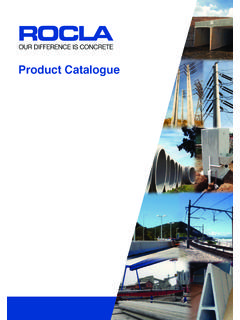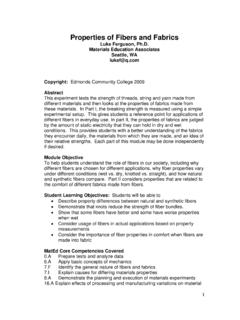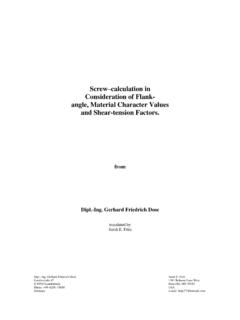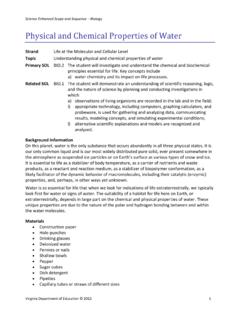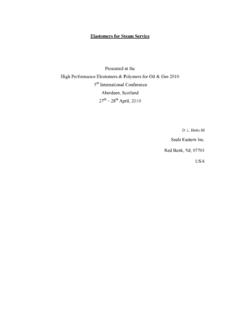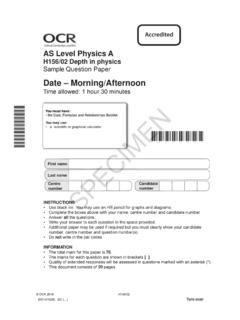Transcription of DESIGN MANUAL FOR CONCRETE PIPE OUTFALL …
1 , Infrastructural Products and Engineering Solutions DivisionDESIGN MANUAL FOR CONCRETE pipe OUTFALL SEWERS DESIGN MANUAL for CONCRETE pipe OUTFALL SewersApril 2009 Page IPREFACER esearch on sewer corrosion commenced at the CSIR in 1950, supported financially by Town Councils and CONCRETE pipe manufacturers. The research was initiated by a report of the Springs Town engineer on the town s OUTFALL sewer and the discussion of the sewer corrosion problem in general at a special combined meeting of the SA Chemical Institute and the SA Branch of The Institute of Sewage Purification as well as the 29th Annual Conference of The Institution of Municipal Engineers (SA District).
2 The general consensus of opinion was that the matter be urgently researched, the task of which was commissioned to the CSIR, which proposed that the research be tackled simultaneously from the following angles:(a) The microbiological aspects to elucidate the mechanism of corrosion.(b) Field aspects that influence corrosion such as DESIGN , construction and operation of sewers.(c) The use of construction materials with enhanced resistance to corrosion. The work culminated in the publication of the research findings in 1958 in CSIR Series 12 book Corrosion of CONCRETE Sewers, which showed that practical, cost-effective steps could be taken to improve the resistance of CONCRETE pipes to sewer corrosion.
3 Particular mention must be made of the finding by JHP van Aardt of the NBRI, CSIR, to improve the resistance of CONCRETE pipes by using calcareous aggregate instead of siliceous aggregate in them, a finding which is since being used corrosion research at the NBRI, CSIR was re-opened in 1964 to establish with what success the recommendations made in the above-mentioned book had been implemented and to research new and modified materials and alternative methods of combating corrosion as well as the economy of implementing the latter. Progress was reported in 1967 in CSIR Research Report 250 Corrosion of Sewers by JL Barnard. The main conclusion was that the 1958 report was well received and the recommendations applied widely.
4 Unfortunately, the research discontinued and the long-term effect of these recommendations and the comparative performance of the various sewer pipe materials remained 1986, Ninham Shand proposed via De Wet Shand that an experimental section of sewer pipe be installed at Virginia, OVS (for which they were the consultants); severely aggressive conditions were expected to occur in the sewer . The experimental section, with full access manholes was completed in 1989. The NBRI, CSIR, was commissioned, with financial assistance from industry, to monitor the condition and performance of the different sewer pipe materials. The results, recorded over the first five years (comprising Phase One), were published in Consolidated Report on Phase 1 of sewer Corrosion Research; The Viginia sewer Experiment and Related Research.
5 The salient outcome was that the various exposed materials could be rated on a scale of 1-10, 1 giving the best resistance to corrosion and 10 the CSIR s involvement in sewer corrosion research at Virginia stopped on completion of Phase One, and monitoring of the experimental line continued, firstly by UCT (Phase Two) and afterwards by UCT and an independent consultant (Phase 3).This MANUAL is a consolidation of important aspect that emerged from research in the RSA and elsewhere on sewer corrosion and the salient aspects that must be considered in the DESIGN of sewers to ensure that they perform satisfactorily for their DESIGN life, namely hydraulic DESIGN , material strengths, imposed loads, sewer corrosion and its control, field testing and the monitoring of sewers.
6 Special mention should be made of the introduction of a material factor in the Life Factor equation to predict the corrosion rate of the material under a given set of corrosive conditions in a sewer to be installed and the section on a procedure for the DESIGN process. The MANUAL would undoubtedly be of great help as a reference to anyone who is involved in sewer corrosion and the DESIGN and installation of sewers to deal with corrosion Kr ger Building Materials Science and Technology Consultant2008-07-01 DESIGN MANUAL for CONCRETE pipe OUTFALL SewersApril 2009 Page IIIC oncrete pipes and manholes are the most frequently used products for OUTFALL sewers. South Africa s CONCRETE pipe industry has grown tremendously over the past eighty years to meet sewer requirements and other technology and SANS (SABS) standards ensure that products with a consistently high quality are produced.
7 Provided sound DESIGN and installation methods are followed, these products will give the desired hydraulic, structural and durability performance for a long service MANUAL is intended to cover all aspects of selecting, specifying and testing CONCRETE pipes for OUTFALL sewers. It does not attempt to replace textbooks or codes, but rather to complement them by providing guidance for designers. The focus is on the prediction and control of CONCRETE sewer corrosion. Sections on hydraulics, pipe strength, product testing and condition assessment have been added so that all aspects of sewer DESIGN and specification are addressed. The Companion publications, The CONCRETE pipe and Portal Culvert Handbook and The CONCRETE pipe and Portal Culvert Installation MANUAL , deal with these other aspects of product selection and product by the American CONCRETE pipe Association have been used freely and acknowledgement is hereby made to that CONCRETE pipe , Infrastructural Products and Engineering Solutions (PIPES) Division of the CONCRETE Manufacturers Association has prepared these publications for the guidance of specifying bodies, consulting engineers and contracting organisations using CONCRETE pipes and portal culverts manufactured in accordance with the relevant SANS (SABS) standards.
8 This is the first edition of this MANUAL and the information presented has been collected from many sources. Constructive criticism is welcome and, where relevant, will be incorporated into future editions. Alaster Goyns (Pr Eng)Produced byPIPES CCPO Box 12519 Clubview0014 DESIGN MANUAL for CONCRETE pipe OUTFALL SewersApril 2009 Page IV-TABLE OF CONTENTS-1. INTRODUCTION .. Background .. Requirements .. Purpose and Scope ..22. HYDRAULIC CONSIDERATIONS .. Some Basic Definitions .. Vertical Alignment .. Basic Principles .. Velocity and Discharge .. Drop Structures .. Further Considerations for Drop Structures .. Horizontal Alignment .. Basic Principle.
9 The Impact of Manholes .. Manhole Pipes .. Distance between Access Points ..133. LOADS ON BURIED PIPES .. Introduction .. Earth Loads .. Trench condition .. Embankment condition .. Jacked Pipeline Installation .. Flexible Pipes .. Traffic Loading ..214. CONCRETE pipe STRENGTHS .. External Internal Pressure .. Safety Factors .. Selecting CONCRETE pipe Class .. External load .. Internal Combined Internal Pressure and External Load .. pipe Bedding and Installation Details .. Jacking Conditions ..27 DESIGN MANUAL for CONCRETE pipe OUTFALL SewersApril 2009 Page V5. CORROSION PREDICTION .. Background .. Corrosion Mechanism .. Corrosion Prediction Sulphide Generation.
10 Hydrogen Sulphide Release .. Acid Formation and CONCRETE Corrosion ..316. CORROSION CONTROL .. Developments in South Africa .. pipe Material Choice for Sewers .. Corrosion Control Layer Thickness and Crack Widths .. Remarks on CAC/DOL Linings .. Notes on HDPE Linings .. DESIGN and Detailing Considerations ..387. FIELD General Comments .. Types of pipe Joint .. Water Testing on Site .. Air Testing on Site ..428. CONDITION OF EXISTING SEWERS .. Aging of Sewers .. pipe Materials .. Condition Assessment .. CCTV Camera Inspections .. Physical Measurement of Corrosion .. Comparing Life Factor Model, CCTV and Physical Inspection Data ..459. CONCLUDING REMARKS ..46 ACKNOWLEDGEMENTS.



